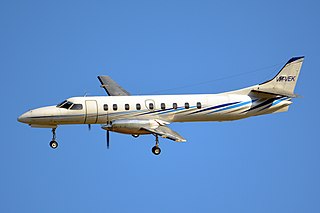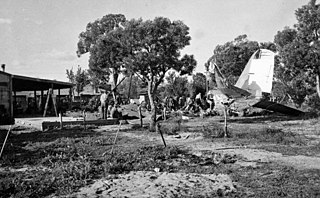
A tailplane, also known as a horizontal stabiliser, is a small lifting surface located on the tail (empennage) behind the main lifting surfaces of a fixed-wing aircraft as well as other non-fixed-wing aircraft such as helicopters and gyroplanes. Not all fixed-wing aircraft have tailplanes. Canards, tailless and flying wing aircraft have no separate tailplane, while in V-tail aircraft the vertical stabiliser, rudder, and the tail-plane and elevator are combined to form two diagonal surfaces in a V layout.

In fluid dynamics, a stall is a reduction in the lift coefficient generated by a foil as angle of attack increases. This occurs when the critical angle of attack of the foil is exceeded. The critical angle of attack is typically about 15°, but it may vary significantly depending on the fluid, foil, and Reynolds number.

A stick shaker is a mechanical device designed to rapidly and noisily vibrate the control yoke of an aircraft, warning the flight crew that an imminent aerodynamic stall has been detected. It is typically present on the majority of large civil jet aircraft, as well as most large military planes.

A conventional fixed-wing aircraft flight control system (AFCS) consists of flight control surfaces, the respective cockpit controls, connecting linkages, and the necessary operating mechanisms to control an aircraft's direction in flight. Aircraft engine controls are also considered as flight controls as they change speed.

The empennage, also known as the tail or tail assembly, is a structure at the rear of an aircraft that provides stability during flight, in a way similar to the feathers on an arrow. The term derives from the French language verb empenner which means "to feather an arrow". Most aircraft feature an empennage incorporating vertical and horizontal stabilising surfaces which stabilise the flight dynamics of yaw and pitch, as well as housing control surfaces.

A yoke, alternatively known as a control wheel or a control column, is a device used for piloting some fixed-wing aircraft.

Air Midwest Flight 5481 was a Beechcraft 1900D on a regularly scheduled passenger flight from Charlotte Douglas International Airport in Charlotte, North Carolina, to Greenville–Spartanburg International Airport in Greer, South Carolina. On the morning of January 8, 2003, the Beechcraft stalled while departing Charlotte Douglas International Airport and crashed into an aircraft hangar, killing all 21 passengers and crew aboard and injuring one person on the ground.

The Fairchild Swearingen Metroliner is a 19-seat, pressurized, twin-turboprop airliner first produced by Swearingen Aircraft and later by Fairchild Aircraft at a plant in San Antonio, Texas.
Aircraft upset is a dangerous condition in aircraft operations in which the flight attitude or airspeed of an aircraft is outside the normal bounds of operation for which it is designed. This may result in the loss of control (LOC) of the aircraft, and sometimes the total loss of the aircraft itself. Loss of control may be due to excessive altitude for the airplane's weight, turbulent weather, pilot disorientation, or a system failure.
A stick pusher is a device installed in some fixed-wing aircraft to prevent the aircraft from entering an aerodynamic stall. Some large fixed-wing aircraft display poor post-stall handling characteristics or are vulnerable to deep stall. To prevent such an aircraft approaching the stall the aircraft designer may install a hydraulic or electro-mechanical device that pushes forward on the elevator control system whenever the aircraft's angle of attack reaches the pre-determined value, and then ceases to push when the angle of attack falls sufficiently. A system for this purpose is known as a stick pusher.

The SAI-Ambrosini SS.4 was an Italian fighter prototype developed in the late 1930s, featuring a canard-style wing layout and a pusher propeller. Development of the SS.4 was abandoned after the prototype crashed on its second flight.

Colgan Air Flight 9446 was a repositioning flight operated by Colgan Air for US Airways Express. On August 26, 2003, the Beechcraft 1900D crashed into water 300 feet (91 m) offshore from Yarmouth, Massachusetts shortly after taking off from Barnstable Municipal Airport in Hyannis. Both pilots were killed.

A flight control mode or flight control law is a computer software algorithm that transforms the movement of the yoke or joystick, made by an aircraft pilot, into movements of the aircraft control surfaces. The control surface movements depend on which of several modes the flight computer is in. In aircraft in which the flight control system is fly-by-wire, the movements the pilot makes to the yoke or joystick in the cockpit, to control the flight, are converted to electronic signals, which are transmitted to the flight control computers that determine how to move each control surface to provide the aircraft movement the pilot ordered.
Several aviation incidents and accidents have occurred in which the control surfaces of an aircraft became disabled, often due to failure of hydraulic systems or the flight control system. Other incidents have occurred where controls were not functioning correctly prior to take-off, either due to maintenance or pilot error, and controls can become inoperative from extreme weather conditions. Aircraft are not designed to be flown in such circumstances; however, a small number of pilots have had some success in flying and landing aircraft with disabled controls.

On 2 July 1949 a Douglas DC-3 aircraft departed from Perth, Western Australia for a night flight of 441 nautical miles (817 km) to Carnarvon. The aircraft climbed to a height of about 500 feet (150 m) and then spiralled almost vertically to the ground, killing all 18 people on board. It crashed about a mile north of Perth airport and burned for over an hour. At the time, it was the worst civil aviation accident in Western Australia.
In aeronautics, loss of control (LOC) is the unintended departure of an aircraft from controlled flight and is a significant factor in several aviation accidents worldwide. In 2015 it was the leading cause of general aviation accidents. Loss of control may be the result of mechanical failure, external disturbances, aircraft upset conditions, or inappropriate crew actions or responses.

Air Algérie Flight 5017 was a scheduled international passenger flight from Ouagadougou, Burkina Faso, to Algiers, Algeria, which crashed near Gossi, Mali, on 24 July 2014. The McDonnell Douglas MD-83 twinjet with 110 passengers and 6 crew on board, operated by Swiftair for Air Algérie, disappeared from radar about fifty minutes after take-off. There were no survivors.

On 13 April 2016, a Britten-Norman BN-2T Turbine Islander operated by Sunbird Aviation crashed about 1,200 m short of runway 7 at Kiunga Airport in the Western Province of Papua New Guinea. The plane pitched up right before the crash, then dropped its right wing and fell almost vertically to the ground. Eleven passengers and the 31-year-old Australian pilot, Benjamin Picard, were killed. Nine people died on impact, with other three declared dead on arrival at Kiunga Hospital.

Atlas Air Flight 3591 was a scheduled domestic cargo flight under the Amazon Air banner between Miami International Airport and George Bush Intercontinental Airport in Houston. On February 23, 2019, the Boeing 767-375ER(BCF) used for this flight crashed into Trinity Bay during approach into Houston, killing the two crew members and single passenger on board. The accident occurred near Anahuac, Texas, east of Houston, shortly before 12:45 CST (18:45 UTC). This was the first fatal crash of a Boeing 767 freighter.

The Maneuvering Characteristics Augmentation System (MCAS) is a flight stabilizing feature developed by Boeing that became notorious for its role in two fatal accidents of the 737 MAX, which killed all 346 passengers and crew among both flights. Systems similar to the Boeing 737 MCAS were previously included on the Boeing 707 and Boeing KC-46, a 767 variant.
















